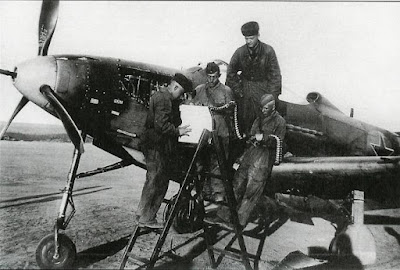The Bell P-39 Airacobra was a single-seat, fighter aircraft used by the US Army's Air forces during World War II. It was employed in every theater of operations from the Pacific to the European. In this armed conflict, it was also used by the Soviet, British, as well as by the Australian and the Free French Air Force. It had a unique and revolutionary design as it had its engine located behind the cockpit. This layout allowed the aircraft to carry the massive 37-mm cannon.
The Bell P-39 Airacobra was originally conceived as a high-altitude interceptor. However, its performance in such a role was poor. Thus, it would be used as low-altitude fighter and ground-attack aircraft, which was effective because of the nose-mounted Oldsmobile 37mm gun. Nevertheless, the Soviet pilots achieved impressive success in air combat, fighting at low levels. Since this American fighter's performance at high altitudes did not match that of the British fighters, the RAF decided to use it only as a ground-attack aircraft. The US Army Air Forces would also employ it in North Africa and Italy.
Below, two Airacobra fighter aircraft flying in the skies over the Pacific in late 1942.
The prototype, the Bell XP-39, first flew on April 6, 1939. The first production aircraft was the P-39D version, which would enter service in July 1941. By September 1942, it had already been assigned to the 67th Pursuit Squadron, operating at Henderson Field, on Guadalcanal Island. 26 Airacobras would be converted to reconnaissance aircraft; it was the P-39D-3 variant, which had K-24 and K-25 cameras mounted in the rear of fuselage. The P-39D would be followed by the P-39F, which introduced an Aeroproducts propeller to replace the former Curtiss type. However, the final and most built versions were the P-39N and P-39Q, which were fitted with more powerful engines, bringing the total number to 9,558 Airacobras having been produced by 1944.
Technical Characteristics
The Bell P-39 was a single-seat, single-engine, all-metal monoplane. It had dihedral, cantilever low-wing. It was powered by one Allison V-1710-85, V-12 piston engine, delivering 1,200 HP. The engine was buried in the fuselage behind the pilot's seat and it was fitted with an extension shaft that extended under the cockpit all the way to the gearbox that connected with the propeller.
The pilot sat in an armor-protected protected cockpit. Bullet-proof protection also included the floor of cockpit, which was very useful in ground-attack missions. The aircraft was also equipped with self-sealing fuel tanks. It was the first fighter to feature a tricycle landing gear; this was due to the cannon and the engine installation.
Specifications (P-39N)
Type: fighter
Length: 9.19 m (30 ft, 2 inch)
Wingspan: 10.36 m (34 ft)
Wing Area: 19.79 m2 (213 sq ft)
Height: 3.78 m (12 ft, 5 inch)
Power Plant: one 1,200-HP, Allison V-1710-85, V-12 engine.
Maximum Speed: 642 km/h (400 mph)
Range: 1,207 km (750 miles)
Service Ceiling: 11,735 m (38,500 ft)
Armament: one 37mm cannon; two 12.7-mm (.50-cal) M2 Browning plus four 7.62mm machine guns in wings. One 227 bomb.
Below, the Bell P-39 in flight off the coast of Guadalcanal in 1942.
The Russian pilots really got the hang of it and got the most out of this fighter, shooting down many German Messerschmitt Bf 109.
Below the P-39D in service with the RAF.
The Airacobra in the skies over North Africa in 1943.




